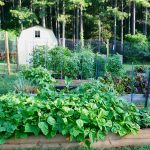Last night we worked until it was too dark to see. After moving some perennials and fussing with the lawn a bit, we decided to do clean up. We have a huge pile of scrap wood – bits and pieces from the porch and garden shed construction, wooden pallets that the shed materials came on – and we have been throwing them into what we call ‘the ravine’ but which is actually an odd, really steep narrow sort of gorge out in the woods. So we hitched the cart to the riding mower and drove another pile to the ravine, where we’re hoping nature will decompose the wood.
The fox den appeared to have been worked on since we were last there, with a branch pulled over the entrance and a second ‘back door’ added. The food scraps we’ve been leaving in the woods were totally gone, much to Shadow’s disappointment (That dog can find anything. She found what looked like deer vertebrae the other day!).
As we were moving the wood back and forth, John stepped on something that gave way. It was a rusty paint can. He brushed his foot over the thick carpet of pine needles and we found more paint cans, a farm bucket, and what looked like an old-fashioned oil can, all so rusted that with one step they crumbled into dust. There was also a bit of decayed work glove.
Looks like someone else had the same idea for that ravine!
We thought it odd to find these in the middle of nowhere, but then we realized that long ago, this wasn’t such a long walk from the old barn and house. Our property was once part of a very large farm. The crumbling remains of the house are just on the other side of our creek. The house looks like it’s from the 1800’s some time and we heard from a neighbor that the date may be right – probably mid 1800’s. The barn is an old tobacco barn and is held up by two huge trees that have grown on either side of it, forming supports. Tobacco barns are open and airy, with long beams near the ceiling. The tobacco plants are hung up inside the barn to dry. They lack animal stalls or other features you’d typically think of in a barn. These buildings aren’t on our land, so we’ve been hesitant to go up and explore.
We’ve found the old fence lines out in the woods. Sometimes it’s what looks like a tree stump, only upon close inspection you realize it’s a fence post. Barbed wire pokes up in odd places from the ground, all rusty and threatening tetanus. We’ve followed what’s left of the wire and it goes along the northern edge of our property following the modern day line. According to neighbors and friends, our land was planted with its current timber crop in the 1980’s. From around 1940 to 1980, it was fields used for cattle, and before that, most likely cattle and tobacco. One neighbor whose family settled the area said tobacco, surely, since that was the big pre and post Civil War cash crop. The old brick tobacco warehouses that line the town of Farmville next to the Appomattox River attest to how important this crop was for the local economy.
Just about 20 feet in from the creek and the old tobacco barn, and just about 10 feet over into our property, we’ve found more relics of the farmers who lived here before us. An old mattress, only the rusty springs poking up.
I keep hoping for Civil War treasure, Indian arrows, or at least another set of bones like the ones I found by the creek (deer pelvis, as it turned out).
But who knows what tomorrow will bring to our farm archaeology?





Good morning Jeanne,
What fun to explore different areas of your farm that seem to be untouched for many years. Given where you live, Civil War artifacts are certainly possible!
I live in Tidewater area, Seaford. It is near Williamsburg, Yorktown, Jamestown area.
Farm archaeology will lead to garden treasure hunt !! … cheers! ~ bangchik
What an enjoyable tour of your ravine! I knew nothing about tobacco barns and it was fun to learn about them. Good luck with the rusty barbed wire 🙁
If you have a resident fox you should read Rita Mae Brown’s fox hunting mysteries, set up in Nelson County, VA. The foxes are the stars.
Thanks Janet for your post. Our friend in Cumberland, Virginia, has a display of mini cannon balls in her living room, all picked up from her fields. Apparently there was a battle there. We know that Ulysses S. Grant, Civil War General and former US President, traveled our road and stayed in the “old brick house of Hixburg”, which was an Inn in his day. So it’s possible! You live in a gorgeous area; I love Williamsburg. Enjoy your day!
Bangchik and Kakdah, thanks for your comment! Now if I can only find old jewels someone buried…LOL…probably not!
Thanks Daffodil Planter! I hope to sketch a diagram of the farm and post it to the blog so folks can see the various areas. We keep naming bits and pieces. Enjoy and have a beautiful day!
Oh and I forgot to add – I love Rita Mae Brown’s series. One of the artists who contributes sculptures to our other company, EquinArt Creations, is a foxhunter near Ms. Brown’s area and has hunted with her! And I love all her books – the animals are just precious (and remind me of my own sweet Shadow and mischievous Pierre).